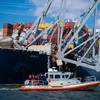Castrol Calls for Clarity on Polar Lubricants Usage
As Polar shipping movements increase, Castrol Marine suggests that greater attention should be paid to the environmental credentials of lubricants used on board in applications where there is a risk of leakages and discharges.
Growing demand for effective shipping routes and cruises to previously inaccessible destinations has led vessels into increasingly sensitive marine areas.
Exemplary is the increasing amount of seaborne traffic beginning to move along the Siberian coast. There are also hopes of opening up more of the North West Passage above Canada.
The Northern Sea Route voyage is one-third of the distance of traditional routes through the Suez Canal, bringing with it lower fuel costs. Nordic Barents operator Nordic Bulk Carriers was recently reported as claiming that an Arctic voyage to Asia would save the company $180,000 in fuel costs over the equivalent journey via the Suez Canal.
Norilsk Nickel, the world's largest nickel producer, carried ore to China and South Korea by the eastern part of the Arctic route last year. Two tankers owned by Murmansk Shipping loaded with petroleum recently moved through the ice-thinned passage from Murmansk to Chukotka in the Russian Far East. Again, Sovcomflot has also taken one of its 70,000dwt tankers from Russia to the Far East on this route, while Russian oil company Novatek has undertaken a trial shipment of 60,000 tons of oil products to China via northern Siberia.
New Responsibilities
With such operations come new responsibilities for shipowners in terms of both safety and the environment. These have been recognized by guidelines issued by the International Maritime Organization’s Maritime Safety Committee and Marine Environment Protection Committee for ships operating in Polar waters.
Among the explicit statements regarding the environment in these Guidelines is the following: “Sterntube bearings, seals and main propulsion components located outside the hull should not leak pollutants.
Pollution resulting from leakages from oil lubricated stern tubes is now widely acknowledged. A joint paper presented to the MEPC by Friends of the Earth International and WWF projected that discharges across the entire marine environment, including open seas to be as much as 244,000 tonnes a year.
Such leakages could be ‘engineered away’, either at the design stage or during refit through using extra seals. However, the costs associated with this make it relatively unlikely that leak-free seals will be adopted by the industry in the near future, unless operators are forced to do so by legislation.
In fact, though, the IMO’s Polar guidelines did not call for an outright ban on oil-lubricating stern tubes, instead stating: “Non-toxic, biodegradable lubricants are not considered to be pollutants”.
Clarity Call
Castrol Marine suggests that there remains lack of clarity in the marine industry on what ‘non-toxic biodegradable lubricants’ performance should be and how it should be measured.
“The claims for ‘environmentally responsible’ products can sometimes be misleading,” says Susannah Linington, Castrol Marine environmental specialist. “For example, terms such as ‘environmentally friendly’, ‘food grade’ or ‘biodegradable’ oils are often used without justification. It is essential that operators ask the right questions about what they are buying into and get the right information to enable the most appropriate products to be selected.”
Linington said that the marine industry needs consistent standards covering the chemicals used on board vessels.
“As any leaked product will go into the sea rather than into freshwater, it is important that marine testing is carried out on the product, not testing in freshwater or in the soil,” said Linington. “The product’s lubricating performance should also be considered alongside its bioaccumulation, marine toxicity, and biodegradability properties in sea water.”
For marine and offshore applications, Castrol has developed a full range of high specification, environmentally responsible lubricants as drop-in replacements for conventional mineral oils in equipment where there is a risk of accidental spillage or leakage into the marine environment. BioStat, for example, is suited for the application in stern tube, reduction gear, thruster, spur, helical and planetary gear units, couplings, rolling and sliding bearings.
BioStat fluids contain selected additives ensuring good oxidation stability, good anti-corrosion and anti-wear properties and low aquatic toxicity, Linington explains. “The marine performance of Castrol BioStat has been measured in comparison with conventional lubricants and has been proven to have superior biodegradation, significantly reduced bioaccumulation and toxicity, and enhanced renewability (that is, products contain components derived from renewable resources).”
Guidance from Offshore?
In assessing the future path of regulation, shipping might do well to consider the more precise approach taken to defining the environmental performance of lubricants in the offshore sector, Ms Linington says.
She points out that many of the Castrol range of environmentally responsible lubricants have undergone full component level marine environmental testing according to the OSPAR (the Oslo and Paris Conventions for the protection of the marine environment of the North-East Atlantic). These products are registered with the Norwegian authorities for use offshore.
UK legislators recently arrived at a new definition of offshore ‘releases’, to provide the basis for enforcement against operators for unintentional chemical releases. Permit holders now have an obligation to prevent damaging incidents or to limit their environmental consequences. Again, the Canadian government recently started asking offshore permit holders for information on the environmental specifications of thruster fluids. Currently, even shipboard lubricants used in Polar waters do not have to undergo the same rigorous environmental testing as those used offshore. However, Linington points out that the final draft of the European Ecolabel for lubricants extends to lubricants in marine applications, suggesting the same exacting standards in defining what constitutes a non-toxic biodegradable lubricant may soon become a feature of maritime regulation. The US Environmental Protection Agency (EPA), for example, is already reviewing criteria in the Vessel General Permit for the selection of environmentally preferable lubricants for use in stern tubes and thrusters, and indeed deck machinery, with a due date for completion of the review by the end of November 2011. Given these trends, Linington says: “The shipping industry needs to review applications that have the potential to discharge lubricants into the sea, either intentionally or by accident, as a matter of urgency, particularly as operations extend into more sensitive seas. It is imperative that owners assess whether they could use products in these applications that have a reduced impact on the marine environment, based on biodegradation, bioaccumulation and toxicity in sea water, while maintaining good lubrication performance.”
As operations extend into ever more sensitive marine environments, such as Polar regions, Castrol believes the time is right for all maritime transport operators in applications at risk of operational discharge to switch to environmentally responsible products.
*(IMO MSC Ref. Resolution A.1024(26). Guidelines for Operating in Polar Waters. Section 7.2.3).
(As published in the October 2011 edition of Maritime Reporter + Engineering News - www.marinelink.com)
















